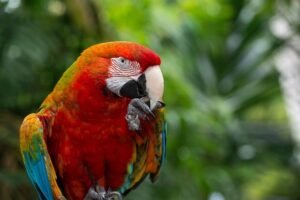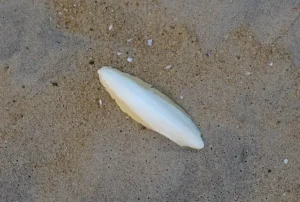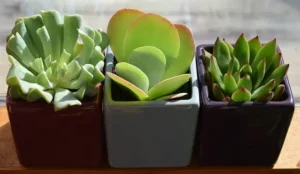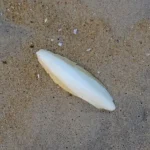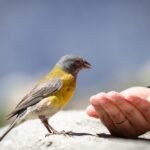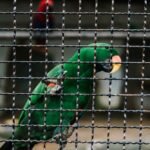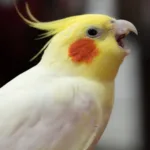Fleas are not as common in parrots as they are in wild birds and poultry. This is because parrots are kept as pets and generally live in clean environments.
However, sometimes even in clean households, parrots can still get infested with bird fleas if their cages are not properly maintained or due to a lack of food hygiene. They can also pick up fleas from other pets like cats and dogs who have routine exposure to the outdoors.
Bird fleas can be treated with the use of topical sprays and antiparasite medications but it’s important to make sure the parrot’s surroundings, like the house and garden, are clean to prevent reinfestations.
Quick Navigation
What Are Bird Fleas?
Bird fleas (Ceratophyllus gallinae) are an ectoparasite that live and feed on avian hosts. These include wild birds as well as pet birds such as parrots. An adult bird flea measures around 2 to 2.5 mm in length.
It has a flat body shape, two eyes, and brown color. The long mouthpart on them called the proboscis is used to suck blood from its host. It also has four to six bristles on the hind leg’s upper part.
Once fleas find a host, they feed on their blood and begin laying eggs. Their lifecycle comprises 4 stages – eggs, larva, pupa, and finally an adult. However, it does not take more than a few days for a flea egg to hatch and start growing.

How Do Parrots Get Fleas?
Much to the confusion and annoyance of bird owners, parrots can pick up fleas from their environment. If you keep your parrot’s surrounding clean and clean its droppings regularly you may be wondering how parrots get fleas.
Fleas usually thrive in unclean environments. They can find their way into your house through pets or through household pests like mice.
Once in the house, fleas look for a host to feed on and multiply. Adult fleas can survive for up to two weeks without finding a host to feed off of. So they have enough time to find a host and start reproducing.
Signs Of Fleas In Parrots
A flea infestation can manifest in various forms. One clear sign is seeing fleas crawling on the parrot’s feathers. They can also cause skin damage but it is often hard to see due to the dense covering of feathers on parrot skin.
Over Preening
Parrots spend a good portion of their day keeping their feathers clean and aligned properly through preening. This and many of their other meticulous grooming habits help to maintain hygiene in the feathers.
However, it can be a concern when they preen excessively. Some parrots may also continuously preen the same area leading to feather damage and bald spots.
Feather Damage
Unlike other animals cannot scratch their skin when they feel itchy. Instead, they use their beaks to find and remove the parasite that might be causing them irritation.
But these external parasites are not easy to find and eradicate by the beak, leading to the parrot over-preening and eventually damaging its feathers.

Visible On Feathers
Bird fleas can be as big as 2.5 mm in size, which is visible to the eyes, unlike other parasites such as mites which as microscopic.
Fleas are also quite active on the feathers as they continually crawl around. If you look closely at an infected parrot’s feathers, you can spot bird fleas moving on them.
What Other Parasites Can Be Mistaken For Fleas?
Parrots can be affected by different types of external parasites that can cause similar symptoms to those caused by fleas.
The treatments for various parasites can be different so it’s important to identify which parasite is causing the issue for your parrot.
In some cases, these parasites cannot be detected by a home examination and it’s a good idea to consult a vet to help identify the specific bug.
Mites
Mites are microscopic creatures that can infest a parrot’s feathers and skin. However, certain types of mites can also infest other parts of the bird’s body and can pose serious health risks.
Feather mites are usually undetectable but their symptoms can be seen. They feed on the parrot’s blood and cause rashes and irritation in the feathers.
Lice
Bird lice are often mistaken for fleas due to their similarities. They are both small wingless arachnids that live on their host’s skin. However, there are some key differences between the two.
Fleas move quicker compared to lice and can also jump from one host to another. Both can grow up to the same size but usually, lice are a few millimeters bigger in size. Lice are dark in color while fleas are reddish brown.
How To Get Rid Of Parrot Fleas
When it comes to dealing with fleas on parrots, most of us parrot owners prefer natural remedies. However, while home remedies can help treat parasites, they cannot provide a permanent solution.
Treatment for fleas or any other parasite should only be given after consulting with an avian vet. If the vet diagnoses fleas on your parrots, it will suggest appropriate medications.
Medications
The vet may recommend an insecticide spray that contains permethrin. According to a study published by Research Gate Permethrin has low toxicity to birds and can be safely used for treating fleas in poultry birds as well as pet birds.
It is important to carefully follow the vet’s instructions when using these insecticide sprays and ensure that it does not come in contact with the parrot’s eyes or nostrils. While applying the spray on your parrot’s feathers, cover its head with a tissue or cloth. This helps protect sensitive areas from the chemical spray.
In some cases, the vet may also recommend oral medications such as ivermectin. It is an effective solution for treating bird fleas. Ivermectin solution can be added to the bird’s drinking water. For the correct dosages and duration of treatment follow your veterinarian’s prescription.
Hygiene
The best way to rid of fleas is to prevent them. After you have removed fleas from your parrot, make sure you have prevention protocols in place. This is to ensure your bird is protected because fleas can still survive in the home environment for quite a long time.
To permanently remove fleas from your house, in the following two-week period, maintain good hygiene. Start by disinfecting your parrot’s cage as there may be some fleas left inside there.
You can use apple cider vinegar solution to clean the cage and parrot toys. It is always better to use non-chemical methods to disinfect your parrot’s belongings.
